

Ley line. Ley lines /leɪ laɪnz/ are supposed alignments of numerous places of geographical and historical interest, such as ancient monuments and megaliths, natural ridge-tops and water-fords.
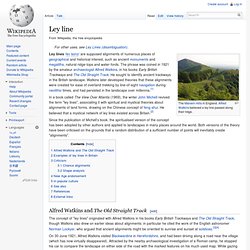
The phrase was coined in 1921 by the amateur archaeologist Alfred Watkins, in his books Early British Trackways and The Old Straight Track. He sought to identify ancient trackways in the British landscape. Watkins later developed theories that these alignments were created for ease of overland trekking by line-of-sight navigation during neolithic times, and had persisted in the landscape over millennia.[1] The Human Chakra System. A strong understanding of the chakra system is very important.
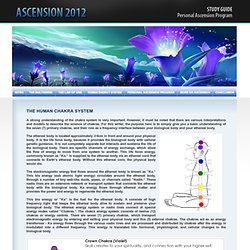
However, it must be noted that there are various interpretations and models to describe the science of chakras. For this writer, the purpose here is to simply give you a basic understanding of the seven (7) primary chakras, and their role as a frequency interface between your biological body and your ethereal body. The ethereal body is located approximately 2-5cm in front and around your physical body. It is the life force body, because it provides the biological body with cellular genetic guidance. Coral Castle. History[edit] According to the Coral Castle's own promotional material, Edward Leedskalnin was jilted by his 16-year-old fiancée Agnes Scuffs in Latvia, just one day before the wedding.
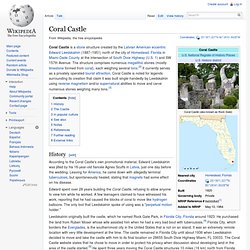
Leaving for America, he came down with allegedly terminal tuberculosis, but spontaneously healed, stating that magnets had some effect on his disease. Edward spent over 28 years building the Coral Castle, refusing to allow anyone to view him while he worked. A few teenagers claimed to have witnessed his work, reporting that he had caused the blocks of coral to move like hydrogen balloons.
The only tool that Leedskalnin spoke of using was a "perpetual motion holder. " Leedskalnin originally built the castle, which he named Rock Gate Park, in Florida City, Florida around 1923. Shield of the Trinity. Earliest attested version of the diagram, from a manuscript of Peter of Poitiers' writings, c. 1210.

The Shield of the Trinity or Scutum Fidei is a traditional Christian visual symbol which expresses many aspects of the doctrine of the Trinity, summarizing the first part of the Athanasian Creed in a compact diagram. In late medieval England and France, this emblem was considered to be the heraldic arms of God (and of the Trinity). Basic description[edit] This diagram consists of four nodes (generally circular in shape) interconnected by six links. Ray of Creation. Ray of Creation The Ray of Creation is an esoteric cosmology which was taught by G.
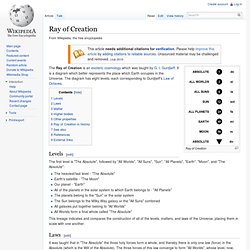
I. Gurdjieff. Sacred geometry. As worldview and cosmology[edit] The belief that God created the universe according to a geometric plan has ancient origins.
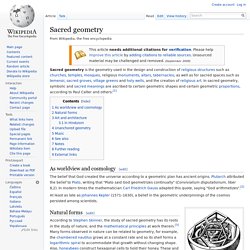
Plutarch attributed the belief to Plato, writing that "Plato said God geometrizes continually" (Convivialium disputationum, liber 8,2). In modern times the mathematician Carl Friedrich Gauss adapted this quote, saying "God arithmetizes".[2] Cymatics. Resonance made visible with black seeds on a harpsichord soundboard Cornstarch and water solution under the influence of sine wave vibration Cymatics (from Greek: κῦμα "wave") is the study of visible sound co vibration, a subset of modal phenomena.
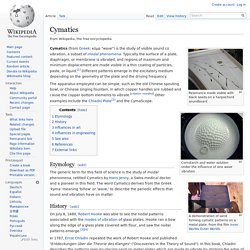
Typically the surface of a plate, diaphragm, or membrane is vibrated, and regions of maximum and minimum displacement are made visible in a thin coating of particles, paste, or liquid.[1] Different patterns emerge in the excitatory medium depending on the geometry of the plate and the driving frequency. The apparatus employed can be simple, such as the old Chinese spouting bowl, or Chinese singing fountain, in which copper handles are rubbed and cause the copper bottom elements to vibrate.
Subconscious. In psychology, the subconscious is the part of consciousness that is not currently in focal awareness. The word subconscious is an anglicized version of the French subconscient as coined by the psychologist Pierre Janet, who argued that underneath the layers of critical thought functions of the conscious mind lay a powerful awareness that he called the subconscious mind.[1] Because there is a limit to the information that can be held in conscious focal awareness, a storehouse of one's knowledge and prior experience is needed; this is the subconscious.[2] The subconscious and psychoanalysis[edit] The subconscious is commonly encountered as a replacement for the unconscious mind and therefore, laypersons commonly assume that the subconscious is a psychoanalytic term; it isn't.
Sigmund Freud explicitly argues: How to Use Your Subconscious to Change Your LifeChange Your Life. “Never go to sleep without a request to your subconscious.” – Thomas Edison Your subconscious loves to do work while your body performs other tasks that are easy.
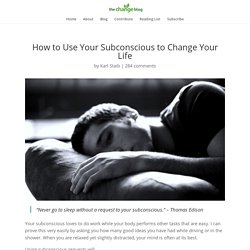
I can prove this very easily by asking you how many good ideas you have had while driving or in the shower. When you are relaxed yet slightly distracted, your mind is often at its best. Using subconscious requests will… Improve your motivation.Help you become happier.Increase your emotional intelligence. You’ll see improvement in less than a month. My last request was… “Please give me more patience when commuting to work and allow me to even enjoy my time in the car.”
Within a month I was enjoying my ride to work. My latest request is… “Let’s find creative ways to grow my blog.” I took this approach because it’s going to take a request to my subconscious and action in my waking life to make this happen. Mindset My mindset is changing by setting my subconscious on a certain issue. Unconscious mind. Some critics have doubted the existence of the unconscious.[2][3][4] Historical overview[edit] The term "unconscious mind" was coined by the 18th-century German romantic philosopher Friedrich Schelling and later introduced into English by the poet and essayist Samuel Taylor Coleridge.[5]
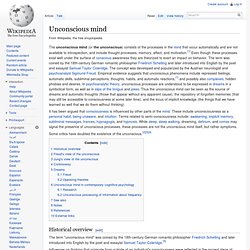
Psychotherapy Arts. Click here for a printer friendly version of this page Everyday experience shows that we seem to function as thought we have two different minds: one that deals with the ordinary affairs of life in this world, and one that deals with what goes on within.

I call them the outer mind and the inner mind. The outer mind is at home in the physical, social, interactive environment of our lives. Working ceaselessly to make things happen, to accomplish what it wants to accomplish, to relate to others as it wishes to relate, to handle life's situations as it chooses, the outer mind is a true citizen of the world, and, like it or not, the outer mind cannot escape this involvement.